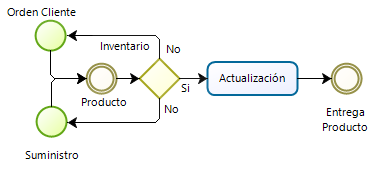Using Discrete Event Simulation to analyze a proposal of improve storage costs
DOI:
https://doi.org/10.17981/bilo.3.1.2021.01Keywords:
Discrete Event Simulation, Merchandise inventory, Storage costs, Missing productsAbstract
Prolonged storage in any company is a problem, because it increases the costs of using the warehouse, in addition, merchandise that is stored for a long time can be damaged, which why this study it is planned. Where is shows the implementation of a simulation models in the storage process of a mobile technology marketing company, with the aim of proposing improvements that reduce the current costs of the system. This, 3 products with the highest turnover were selected. It used Arena® software to model the system from historical data of the demands and the orders made in the previous periods. After applying the model, it was found that a good strategy to reduce costs is to modify the quantity request, more specifically to increase that of products 1 and 2, and reduce that of product 3. The results showed that the biggest inventory stock out are of the first two products. Therefore, different alternatives were proposed for each one of the products; Therefore, it is concluded that proposal 1 is the most recommended to use, due since it is not very invasive and does not affect the relationship of customers and suppliers.
Downloads
References
Patiño Builes, A. (2015). Tendencias tecnológicas que influyen en el aumento de la productividad empresarial. INGE CUC, 11(2), 84-96. https://doi.org/10.17981/ingecuc.11.2.2015.09.
R. Jiraruttrakul, S. Smutkupt, W. Marksin, L. Liu, and C. Thanathawee, “APPLYING AN EOQ MODEL TO REDUCE AN INVENTORY COST,” J. Supply Chain Manag. Res. Pract., vol. 11, no. 1, pp. 46–55, 2017.
J. L. C. Corea, J. E. D. Camejo, O. D. F. Espinoza, and H. Y. L. Gutiérrez, “POLÍTICA DE INVENTARIOS
A. Mogrovejo Del Salto, “Estimar mediante simulación el inventario a comprar considerando predicciones de la demanda de los productos,” Universidad Politécnica de Catalunya, 2018.
N. Baharom and P. Hamzah, “Inventory Optimization Using Simulation Approach,” J. Comput. Res. Innov., vol. 3, no. 2, pp. 38–47, 2018.
M. M. Molina Aguirre and A. G. Flórez Gómez, DISEÑO DE LA DISTRIBUCIÓN FÍSICA DE LA BODEGA DE MERCADEO DE LA UNIVERSIDAD DEL NORTE PARA MEJORAR LAS DISTANCIAS RECORRIDAS. Universidad del Norte, 2018.
D. P. LOPEZ PALLARES and L. M. FONTALVO MERCADO, “DISEÑO DE UNA PROPUESTA DE MEJORA PARA LA REPOSICIÓN DE INVENTARIOS A TRAVES DE LA SIMULACION EN LA LINEA DE VEHICULOS LIVIANOS DE UNA EMPRESA DISTRIBUIDORA DE AUTOPARTES,” UNIVERSIDAD DE LA COSTA, CUC, 2019.
V. T. Kim Cuc, N. Truong Thi, and N. T. Le Thuy, “A Simulation Modelling Approach for Selection of Inventory Policy in a Supply Chain,” in International Conference on System Science and Engineering (ICSSE), 2019, pp. 349–354.
G. Xu, J. Feng, F. Chen, H. Wang, and Z. Wang, “Simulation-based optimization of control policy on multi-echelon inventory system for fresh agricultural products,” Int. jourrnal Agric. Biol. Eng., vol. 12, no. 2, pp. 184–194, 2019, [Online]. Available: http://www.ijabe.org/index.php/ijabe/article/view/2834
J. Reyes et al., “A Study on Modeling and Simulation of Automobile Painting Process Based on Flexsim,” in International Conference on Computer Science, Electronics and Industrial Engineering (CSEI), 2019, pp. 260–273, [Online]. Available: https://link.springer.com/chapter/10.1007/978-3-030-33614-1_18
C. A. RESTREPO ZULUAGA and C. A. AGUDELO MURILLAS, DIAGNÓSTICO Y PROPUESTA PARA EL MEJORAMIENTO DEL SISTEMA DE GESTIÓN DE INVENTARIOS EN LA FERRETERIA Y DEPÓSITO LAS PALMAS S.A.S. 2016.
S. A. Khan, F. Dweiri, and A. Chaabane, “MANAGING WAREHOUSE INVENTORY: A SIMULATION BASED CASE STUDY,” in 11th International Conference on Modeling, Optimization and Simulation - MOSIM’16, 2016.
M. A. Samad and V. Anand, “Inventory Simulation Model of a Lamp of Maintenance Warehouse of Facilities Management Department at Southeast Missouri State University Using Arena,” Univers. J. Eng. Sci., vol. 4, no. 2, pp. 15–21, 2016.
J. R. Cantú González, M. del C. Guardado García, and J. L. Balderas Herrera, “SIMULACIÓN DE PROCESOS, UNA PERSPECTIVA EN PRO DEL DESEMPEÑO OPERACIONAL,” Rev. Iberoam. Prod. Académica y Gestión Educ., vol. 3, no. 5, 2016.
B. V. S. Suraj, S. S. Kumar, and S. Routroy, “Positioning of Inventory in Supply Chain Using Simulation Modeling,” IUP J. Supply Chain Manag., vol. 13, no. 2, pp. 20–32, 2016.
M. A. Álvarez Rangel, “Simulación de un sistema de surtido de rollos para el área de corte,” 2017.
R. D. Diuza Vallejo, “Diseño de una metodología para el uso de la simulación como herramienta para la enseñanza de la gestión de operaciones en la cadena de suministro,” Universidad Autónoma del occidente, 2016.
A. Parra Arenas, “Propuestas de mejora del sistema de distribución de aguacate hass para las exportaciones colombianas mediante simulación,” Universidad autónoma de nuevo león, 2018.
A. A. Giubergia, V. Gil Costa, Y. Mansilla, D. Narváez, M. E. Bertello, and M. Besso, “Simulación aplicada al cálculo de capacidades de almacenamiento y stock piles,” Minería y Geol., vol. 32, no. 2, pp. 70–86, 2016, [Online]. Available: https://www.redalyc.org/pdf/2235/223545820005.pdf
S. Huihui, M. Xiaoxia, and M. Xiangguo, “Simulation and Optimization of Warehouse Operation Based on Flexsim,” J. Appl. Sci. Eng. Innov., vol. 3, no. 4, pp. 125–128, 2016, [Online]. Available: http://www.jasei.org/PDF/3-4/3-125-128.pdf
D.C. Landinez-Lamadrid, D. G. Ramirez-Ríos, D. Neira Rodado, K. Parra Negrete and J.P. Combita Niño “Shapley Value: its algorithms and application to supply chains,” INGE CUC, vol. 13, no. 1, 2017. DOI: http://dx.doi.org/10.17981/ingecuc.13.1.2017.06


 English
English
 Español (España)
Español (España)
